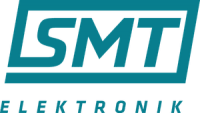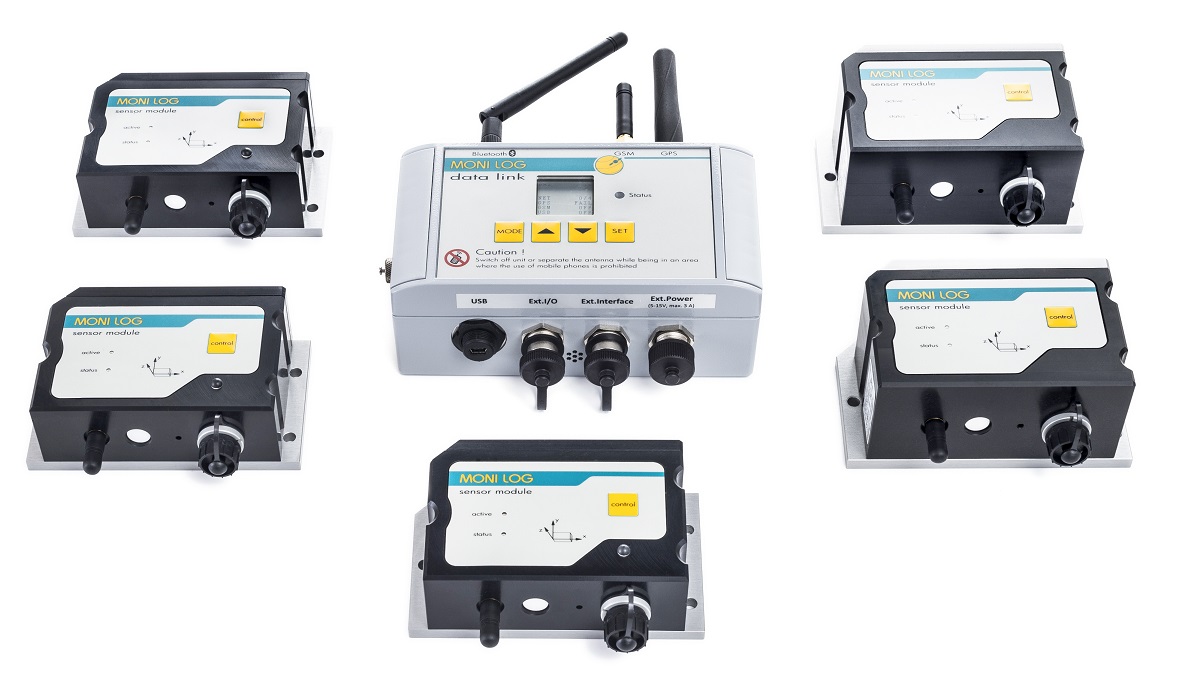Transport Shock Monitoring


MONI LOG® Sensor network
Smart Network System For Transport Monitoring
- Radio sensor network compromising up to 8 autonomous sensor modules
- For the long-term monitoring of oversizing systems and machines
- Continuously records shock, slope, temperature, humidity, pressure and incidence of light
- Provide real-time monitoring of sensitive transports for optimum conditions in transport, packaging and storage
- Automatic transmission of GPS geo-position, data measurements, alarm and status signals by e-mail
- Centralized GSM/UMTS transmission unit with integrated GPS receiver for exact position determination
- Variable configurations for customized applications
- Individually-adjustable registration and alarm thresholds, scalable number of measuring points
- Ultra-long operating time and high reliability even under extreme environmental conditions
- Incorporates powerful, license-free PC software, password-protected and secured against malevolent attacks
- Cloud-based web portal for convenient on-line administration and tracking of transportation route
- Exact evidence of the transport quality
The MONI LOG® sensor network consists of a base station, MONI LOG® data-link sensor and up to 8 further MONI LOG® sensor modules of radio data loggers. Using their network link, the compact, energy-efficient and high-sensitivity sensor modules capture data relevant to transport, such as shocks, acceleration, temperature, humidity, air pressure, inclination and light.
All data are collected via a Bluetooth low-energy radio interface in the base station. It transmits them at adjustable intervals via email, at predetermined intervals over a mobile phone network, to a corresponding receiver or directly to the MONI LOG® web portal. If a configured limit value for measuring data is exceeded, a signal is transmitted to the base station. An alarm signal is then immediately generated and sent via e-mail along with GPS coordinates.
Critical events during a transport are thus tracked and addressed in real time allowing quick mitigation of any possible risk to the sensitive load. If an UMTS connection is not available, the base station changes automatically to an available GPRS network. The stored GPS coordinates are easily imported in Google Earth® and represented graphically. Thus allowing event-controlled positioning as well as route monitoring in the event of an alarm.
The small radio data loggers can be installed particularly well in places which are difficult to access or move. Robust housings protect the devices of the sensor network from dust and splash water.
An optimized energy management guarantees a long-lasting and maintenance-free operation. Standard alkaline or lithium-batteries ensure runtimes in excess of 2 years, even under extremely harsh conditions. The sensor modules have been speci cally designed for long term measurements and are especially well suited for the monitoring of sensitive transports over large distances and goods in critical environments.
All sensor network functions can be easily customized to a specific application by using the user-friendly, license-free PC software MONI LOG® ANALYZER. All recorded data is displayed clearly in measured value tables and diagrams and can be exported to external programs such as Microsoft Excel. Data analysis can be used to reconstruct probable causes of damage, as well as, to optimize dispatch procedures. The MONI LOG® sensor network is an indispensable resource in the safeguarding of sensitive goods during storage and transport in the global freight traffic, be it transportation by road, rail, water, air or any combination thereof.
MONI LOG® data link sensor
Radio base station with GPS receiver and GSM/UMTS transmission unit
| Technical data | |
|---|---|
| Housing: | Housing material: Aluminium, paint-coated Degree of protection: IP 65 Weight: 1.15 kg (standard implementation including batteries) 3.35 kg (option with external battery box, batteries, magnetic mounting feet) Dimensions (H x W x D): 160 x 90 x 60 mm (standard implementation) 230 x 130 x 145 mm (option with external battery box and magnetic mounting feet) Assembly type: Surface mounting (screwed connection recommended), alternatively magnetic-foot mounting |
| Operating/Storage conditions: | -20° C to +70° C with alkaline batteries -40° C to +85° C with lithium batteries |
| Voltage supply internal: | 4 batteries of the type C and R14 (replaceable), alkaline batteries (each 1.5 V), lithium batteries (each 3.6 V) Operating time up to 1 year (with email interval of 24 h) or for 2 years with external battery box |
| Voltage supply external: | 5 – 15 V (max. 3 A) or battery box with 4 battery types D (R20) |
| External interfaces: | USB 2.0 Client (Mini-USB AB) Digital inputs/outputs: 2 switching inlets and 2 switching outputs (M12-plug optional) |
| Display and control elements: | Display: Bistable monochrome display (96 x 96 pixels) LED: Status-LED (red/green) Keys: 4 operating keys for menu navigation and user inputs |
| GPS: | Channels: 22 Antenna: SMA socket for the connection of an external active antenna 50 Ω 3 – 30 mA/3 V/rod or cable antenna) |
| Mobile communications: | Frequency ranges: Quad Band EGSM/GPRS (850/900/1800/1900 MHz) Triple Band UMTS/HSPA (850/1900/2100 MHz) SIM card: Receptacle for 1.8 or 3 SIM card Standard SIM, micro SIM (on request) |
| Bluetooth: | Version: Bluetooth 4.0 Low Energy (master role) Encryption: AES-128 Radio link: Simultaneous 2.4 GHz radio link to up to 8 MONI LOG® sensor modules (for data synchronization and device configuration) |
| Data memory: | Data reception: At least 10 years (independent of battery status) Memory type/size: 512 MB flash parameter and data storage |
| Device certifcation: | CE, IC, FCC, registration with Bluetooth SIG |
MONI LOG® sensor module
Universal radio data logger to record acceleration/shock, inclination, temperature, humidity, air pressure and incidence of light
| Technical data | |
|---|---|
| Housing: | Housing material: PVC + aluminium Degree of protection: IP65 Weight: 0.385 kg (standard implementation including 1 battery) 0.455 kg (variant 2LR6 including 2 batteries) 38 g (each with magnetic base, 3 items per module optional) Dimensions (H x W x D) 120 x 72 x 41 mm (standard implementation) 120 x 72 x 54 mm (variant 2LR6) Ø 25 mm x 15 mm (small magnetic base) Assembly type: Surface mounting (screwed connection recommended), alternatively magnetic-base mounting (on request) |
| Operating / Storage condition: | -20° C to + 70° C with alkaline batteries -40° C to + 85° C with lithium batteries |
| Voltage supply internal: | 1 battery type AA or R6 lithium 3.6 (standard implementation) or 2 batteries type AA or R6 lithium or alkaline (variant 2LR6 or 2LR6AL) or 6 batteries type AA or alkaline R6 as a battery pack (variant 6LR6AL) Operating time dependent on the model and settings e.g. 1*R6: 2 years (with synchronisation interval 10 min); 2 years (2LR6, 6LR6AL) |
| External interfaces: | USB 2.0 Client (Mini-USB OFF) |
| Display and control elements: | LED: 1 green activity-LED + 1 red status-LED Key: 1 operating key |
| Bluetooth: | Version: Bluetooth 4.0 Low Energy (slave role) Encryption: AES-128 Radio link: 2.4 GHz to MONI LOG® data link sensor |
| Data memory: | Data reception: Minimum 10 years (independent of battery status) Storage type / size: 32 MB ash parameter and data storage |
| Device sensors: | |
| Acceleration / Shock (Shock-sensor modules only): | Measuring range: ±16 g (3-axes) – (optionally 100 g; from 3 g 1 kHz) Tolerance: ±0.32 g – (±2 g) Data records: 256 curves in case of exceeding a registration threshold of 0.3 g, a shock curve is recorded (2 kHz, 1 s). the 256 highest shock curves are stored. |
| Temperature: | Measuring range: -40° C – 85° C Tolerance: ±0.5° C Data records: 200,000 |
| Relative humidity: | Measuring range: 0% RH -100% RH Tolerance: ±2% RH Data records: 200,000 |
| Air pressure: | Measuring range: 260 – 1260 mbar (optional 10 – 2000 mbar) Tolerance: ±2 mbar (±4 mbar) Data records: 200,000 |
| Light: | Measuring range: 0 lx – 188000 lx Tolerance: ±10% Data records: 200,000 |
| Slope: | Slope calculation from static acceleration in case of exceeding a slope threshold, a slope curve (10 Hz, 8 s) is recorded. Tolerance: ±3 degrees Data records: 320 curves |
| Conformity: | Device certi cation to CE, IC, FCC Registration with Bluetooth SIG Shock evaluation according to EN 15433-6 Frequency analysis according to EN 13011 |





